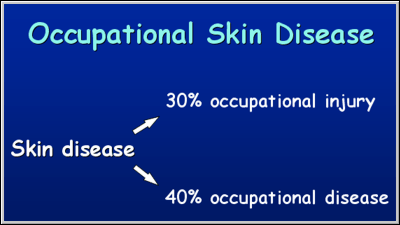 |
| Module 4: Occupational Skin Disease - |
 |
| Module 4: Occupational Skin Disease - |
The father of Occupational Medicine was Bernadino Ramazzini. In his "Discourses on the Diseases of Workers" he stated that:
In 1775 occupational chemical carcinogens were recognised by Percivall Pott when he identified coal tar as the cause of genital carcinomas in chimney sweeps. In 1895 patch testing was introduced by Jadassohn to identify causes of allergic skin disease. However it was only with the technological advances of the industrial revolution, introducing many varied new irritants and allergens into the workplace that occupational medicine really came into its own.
Occupational skin disease accounts for approximately 70% of skin diseases that will be noted in an occupational or work environment. Incidental conditions that do not necessarily have an occupational aetiology, such as chicken pox, account for the other 30%.

Of the occupational skin diseases, 30% are due to injuries. These are acute and easily identified and include lacerations, cuts, abrasions and thermal, chemical and electrical burns. Injuries will not be discussed further.
The rest of this discussion will elaborate on the 40% of occupational skin diseases that will be encountered in the workplace.
Occupational skin diseases comprise skin diseases per se or skin signs of systemic disease.
The skin manifestations of systemic disease can be representative of a systemic disease caused by exposure in the work place. Examples of this would be porphyria cutanea tarda precipitated by tetrachlorodiabenzodioxin exposure or progressive systemic sclerosis that was first described on the mines of South Africa as a consequence of respiratory exposure to silica.
The skin might have been the source of exposure precipitating systemic disease without itself showing damage. Experiments done using various organic solvents have shown that absorption through the skin can result in much higher blood levels of these chemicals compared to absorption through the respiratory tract. Remember that any product that is absorbed through the respiratory tract will have been in contact with the skin long before it gains access to the lungs. Often this skin exposure is not recognised, as it does not necessarily cause discomfort whereas respiratory exposure might precipitate protective mechanisms such as coughing and respiratory distress. Early manifestations of irritation of the skin are often ignored by the patient and management and accepted as "part of the job".

Postgraduate Diploma in Occupational Health (DOH) - Modules 3 – 5: Occupational Medicine & Toxicology by Prof Rodney Ehrlich & Prof Mohamed Jeebhay is licensed under a Creative Commons Attribution-NonCommercial-ShareAlike 3.0 Unported License.
Permissions beyond the scope of this license may be available at http://www.healthedu.uct.ac.za/